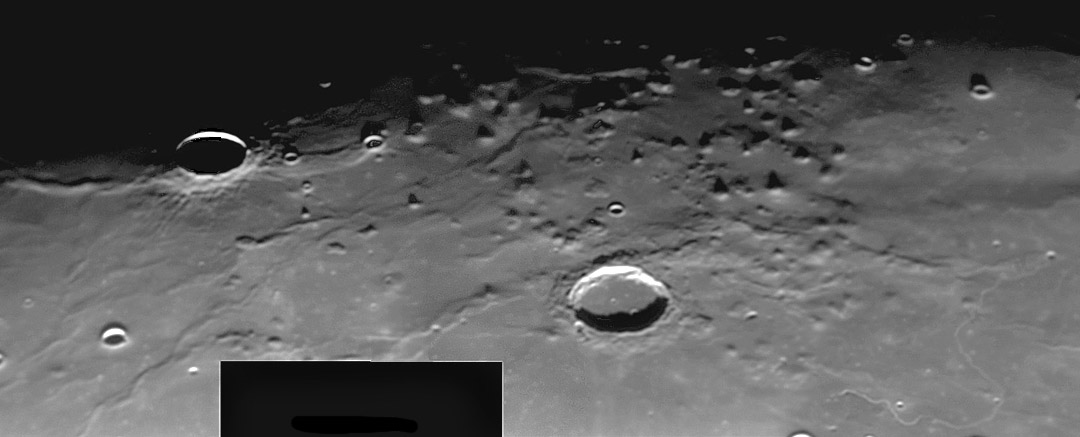|
|
| (3 intermediate revisions by the same user not shown) |
| Line 1: |
Line 1: |
| | __NOTOC__ | | __NOTOC__ |
| | =Domes, Domes Everywhere= | | =Domes, Domes Everywhere= |
| | + | <!-- Start of content --> |
| | <div class="post" id="post-290"> | | <div class="post" id="post-290"> |
| | | | |
| Line 6: |
Line 7: |
| | <p>[[File:MariusJimlpod.jpg|Marius-Phillips]]<br /> | | <p>[[File:MariusJimlpod.jpg|Marius-Phillips]]<br /> |
| | <em>image by [mailto:thefamily90@hotmail.com Jim Phillips]</em></p> | | <em>image by [mailto:thefamily90@hotmail.com Jim Phillips]</em></p> |
| − | <p>The Marius Hills are one of the delightful mysteries of the Moon. Why is there a strong concentration of domes there? Why are most of the domes steep-sided (notice the triangular shadows on Jim’s low-Sun view)? And why do most of the hemispherical domes lack summit pits? I don’t have the answers for these questions, but this image reveals other features of the Marius Hills that are not well known or may even be unknown. For example, at the far right of the image there is a roughly 50 km wide (for comparison, Marius is 41 km in diameter) rough area that seems to be higher in the center, and to have serated edges to the north (right). This looks like a large volcanic outpouring. It is not very high or steep so perhaps it should be called a dome, but it is different in character to most domes, even large ones like the Valentine Dome and the Gardner Mega-Dome. I would prefer to call it a shield volcano, which on Earth is typically larger than a volcanic dome and perhaps less regular in shape. Also look at the trough at the north end of the image - its just below the shield volcano and extends 100 or more kilometers northward. Large troughs typically form where there is extension - the two sides are pulled away from each other. Again, I don’t know if the trough is real and what its significance is, but it may relate to the fundamental problem of why does the Marius Hills volcanic complex exist. Aren’t you glad you read LPOD to get all your questions answered? Finally, make sure you compare this image with the excellent high Sun [http://www.lpod.org/?m=20060121 view] taken by Jérôme Grenier.</p> | + | <p>The Marius Hills are one of the delightful mysteries of the Moon. Why is there a strong concentration of domes there? Why are most of the domes steep-sided (notice the triangular shadows on Jim’s low-Sun view)? And why do most of the hemispherical domes lack summit pits? I don’t have the answers for these questions, but this image reveals other features of the Marius Hills that are not well known or may even be unknown. For example, at the far right of the image there is a roughly 50 km wide (for comparison, Marius is 41 km in diameter) rough area that seems to be higher in the center, and to have serated edges to the north (right). This looks like a large volcanic outpouring. It is not very high or steep so perhaps it should be called a dome, but it is different in character to most domes, even large ones like the Valentine Dome and the Gardner Mega-Dome. I would prefer to call it a shield volcano, which on Earth is typically larger than a volcanic dome and perhaps less regular in shape. Also look at the trough at the north end of the image - its just below the shield volcano and extends 100 or more kilometers northward. Large troughs typically form where there is extension - the two sides are pulled away from each other. Again, I don’t know if the trough is real and what its significance is, but it may relate to the fundamental problem of why does the Marius Hills volcanic complex exist. Aren’t you glad you read LPOD to get all your questions answered? Finally, make sure you compare this image with the excellent high Sun [[January_21,_2006|view]] taken by Jérôme Grenier.</p> |
| | <p>[mailto:tychocrater@yahoo.com Chuck Wood]</p> | | <p>[mailto:tychocrater@yahoo.com Chuck Wood]</p> |
| | <p><b>Technical Details:</b><br /> | | <p><b>Technical Details:</b><br /> |
| Line 13: |
Line 14: |
| | <p><b>Related Links:</b><br /> | | <p><b>Related Links:</b><br /> |
| | Rükl plates 18 & 29<br /> | | Rükl plates 18 & 29<br /> |
| − | [http://www.lpod.org/?m=20060223 Part of the southern Marius Hills]</p> | + | [[February_23,_2006|Part of the southern Marius Hills]]</p> |
| | <p><b>Yesterday's LPOD:</b> [[May 21, 2006|Cherubs in the Corners]] </p> | | <p><b>Yesterday's LPOD:</b> [[May 21, 2006|Cherubs in the Corners]] </p> |
| | <p><b>Tomorrow's LPOD:</b> [[May 23, 2006|Silly Names]] </p> | | <p><b>Tomorrow's LPOD:</b> [[May 23, 2006|Silly Names]] </p> |
| − | <p align="center"><b>Yesterday only 1.6% of LPOD readers clicked on a sponsor - Thanks!<br />
| |
| − | <!-- Removed reference to store page -->
| |
| | </div> | | </div> |
| | + | <p> </p> |
| | + | <p> </p> |
| | + | <p> </p> |
| | + | <!-- End of content --> |
| | {{wiki/ArticleFooter}} | | {{wiki/ArticleFooter}} |




